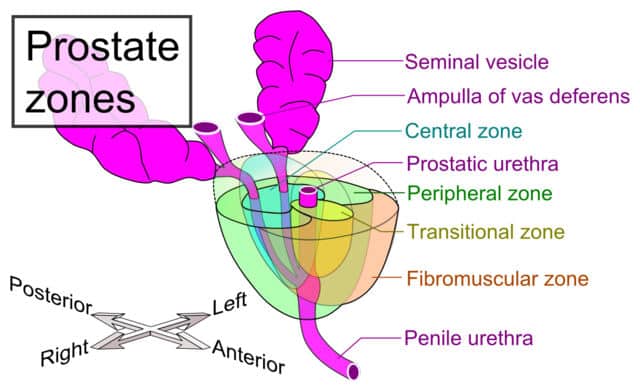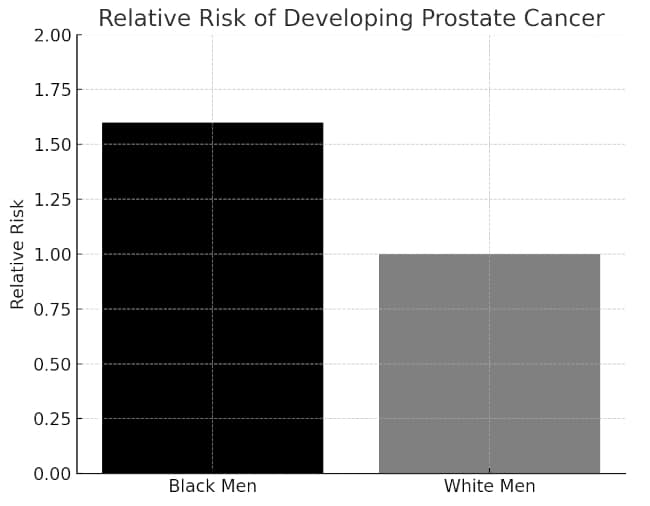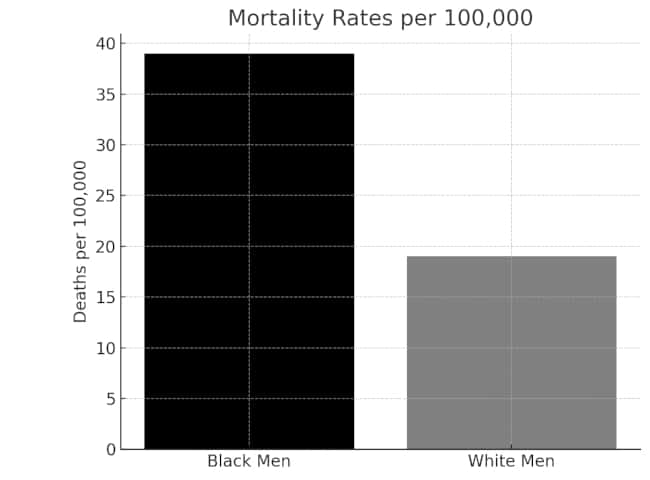Last Updated on July 7, 2024 by Max
Introduction
Prostate cancer is hitting our brothers, fathers, and friends hard, especially Black men. It’s like standing at a crossroads, not sure which way to go—towards hope or facing the tough reality. This blog is about finding the right path to beat prostate cancer together.
Why are Black men more affected by prostate cancer than others? How can we fight back? The answers aren’t just in the hospital; they’re also in our hands, in our communities. This is about getting the right information, catching the disease early, and getting the best treatment out there. It’s more than a blog post; it’s a call to action. Let’s be the change we want to see.
- Introduction
- Understanding Prostate Cancer: Types, Stages, and Diagnostic Indicators
- Prostate Cancer Incidence and Mortality Rates Among Black Men
- Genetic, Environmental, and Socioeconomic Factors Affecting Prostate Cancer in Black Men
- The Lifeline of Early Detection: Enhancing Prostate Cancer Survival Rates
- Emerging Horizons in Prostate Cancer Screening: Technologies and Biomarkers
- Navigating Traditional Prostate Cancer Treatments: Surgery, Radiation, and Hormone Therapy
- Recent Advances in Prostate Cancer Treatment
- Evidence-Based Lifestyle Changes to Reduce the Risk of Prostate Cancer
- Community Resources, Support Groups, and Organizations
- Research and Clinical Trials Focused on Prostate Cancer in Black Men
- Conclusion
- References
Understanding Prostate Cancer: Types, Stages, and Diagnostic Indicators
Prostate cancer represents a significant health challenge, particularly in its diversity and progression. By breaking down its types, stages, and critical diagnostic markers like the Gleason score and PSA levels, we can offer a clearer picture of the disease’s complexity and how it’s assessed and categorized.
Types of Prostate Cancer

- Adenocarcinomas: Accounting for approximately 95% of cases, this type originates in the gland cells of the prostate. It’s the primary focus for screening and treatment in the fight against prostate cancer.
- Small Cell Carcinomas: These rare cancers, making up less than 1% of cases, grow quickly and are more challenging to detect and treat due to their aggressive nature.
- Sarcomas and Transitional Cell Carcinomas: Together, these account for a small fraction of prostate cancers. Sarcomas arise from the prostate’s supportive tissues, and transitional cell carcinomas start in the urinary tract cells within the prostate, each presenting unique challenges in management and treatment.
Stages of Prostate Cancer
The stages of prostate cancer are determined by several factors, including the size of the tumor, its growth rate, and whether it has spread beyond the prostate:

| Stage I | The cancer is small, confined to the prostate, and often undetectable by imaging. Typically, PSA levels are low (<10 ng/mL), and the Gleason score, which rates the cancer’s aggressiveness, is ≤6, indicating a well-differentiated, less aggressive cancer. |
| Stage II | At this stage, the cancer is larger but still confined to the prostate. PSA levels may be moderately elevated (10-20 ng/mL), and the Gleason score ranges from 7, suggesting a moderately differentiated cancer that poses a greater risk of growth and spread. |
| Stage III | Cancer has begun to spread beyond the prostate to nearby tissues, indicating a more aggressive disease. PSA levels often exceed 20 ng/mL, and the Gleason score is between 8-10, pointing to poorly differentiated, highly aggressive cancer cells. |
| Stage IV | This advanced stage means the cancer has metastasized to distant parts of the body, such as bones, lungs, or liver. PSA levels can be very high, and the Gleason score is typically 8-10, reflecting the cancer’s aggressive nature and poor differentiation. |
Understanding these details—types of prostate cancer, stages of progression, Gleason scores, and PSA levels—empowers patients and healthcare providers to make informed decisions regarding screening, diagnosis, and treatment.
Prostate Cancer Incidence and Mortality Rates Among Black Men


The incidence of prostate cancer in Black men is alarmingly high, significantly surpassing that of their white counterparts. Research reveals that Black men have approximately a 60% higher risk of developing prostate cancer. According to the American Cancer Society, the likelihood of a Black man being diagnosed with prostate cancer is 1 in 7, compared to 1 in 8 for men of other races. The disparity deepens when examining mortality rates. Black men are twice as likely to die from prostate cancer as white men. Mortality data from the American Cancer Society indicates that the death rate for Black men with prostate cancer is about 39 per 100,000, compared to 19 per 100,000 for white men. These figures not only reflect the harsh reality of racial disparities in health outcomes but also signal the need for equitable healthcare solutions.
Genetic, Environmental, and Socioeconomic Factors Affecting Prostate Cancer in Black Men
The disparities in PC incidence and mortality rates among Black men are the result of a complex interplay of genetic, environmental, and socioeconomic factors.
Genetic predispositions play a significant role in the increased risk of prostate cancer among Black men. Research has identified specific genetic mutations and variations more prevalent in Black populations that may contribute to this risk. For instance, a study published in the “Journal of Clinical Oncology” found that certain genetic markers associated with prostate cancer risk were significantly more common in Black men compared to white men (Haiman, C.A., et al., 2013). These genetic factors not only influence the likelihood of developing prostate cancer but also its aggressiveness and potential resistance to standard treatments.
Environmental exposures and lifestyle choices also contribute to the disparity in prostate cancer outcomes. Factors such as diet, physical activity, and exposure to carcinogens have been linked to prostate cancer risk. A notable study in “Cancer Epidemiology, Biomarkers & Prevention” highlighted that dietary patterns, particularly high consumption of red and processed meats, and low intake of fruits and vegetables, were more prevalent among Black men and associated with an increased risk of prostate cancer (John, E.M., et al., 2016). These findings point to the role of environmental and lifestyle factors in modulating prostate cancer risk and outcomes. Socioeconomic status (SES) significantly influences the incidence and mortality rates of PC among Black men. Lower SES is associated with reduced access to healthcare, including cancer screening and early treatment services, which contributes to late-stage diagnoses and poorer outcomes. A comprehensive review in the “American Journal of Public Health” emphasized that Black men often face barriers to healthcare access due to socioeconomic disparities, leading to delayed diagnoses and treatment initiation (Shavers, V.L., et al., 2012). This lack of access exacerbates the existing disparities in prostate cancer survival rates.
The Lifeline of Early Detection: Enhancing Prostate Cancer Survival Rates
Early detection of prostate cancer is a crucial lifeline that significantly boosts survival rates. This is especially true for Black men, who face a higher risk and mortality rate from PC compared to their white counterparts.
The Prostate-Specific Antigen (PSA) test, a simple blood test that measures the level of PSA in the blood, is a primary tool for early detection. Studies underscore the importance of PSA screening in identifying prostate cancer at an early, more treatable stage. For instance, a landmark study in the “New England Journal of Medicine” revealed that PSA screening could reduce the risk of death from PC by up to 20% (Andriole, G.L., et al., 2009). This statistic highlights the potential lifesaving impact of early detection through regular screenings.
Despite the benefits of PSA screening, disparities exist in its utilization among different racial groups. According to research from the “Journal of the American Medical Association” (JAMA), the percentage of Black men undergoing PSA screenings is approximately 52%, compared to 60% among white men (Drake, B.F., et al., 2016). This disparity in screening rates contributes to later-stage diagnoses and poorer outcomes for Black men.
Early detection through PSA screening not only aims to reduce mortality but also to preserve the quality of life by enabling less invasive treatment options with fewer side effects. Evidence from the “Journal of Urology” supports that early-stage prostate cancer diagnosed through screening is associated with significantly higher 10-year survival rates (Pinsky, P.F., et al., 2017). For Black men, who are more likely to develop aggressive forms of prostate cancer, early detection is even more critical. Studies show that when diagnosed early and given equal treatment, Black men have survival outcomes comparable to those of other races (Mahal, B.A., et al., 2018). The challenge remains to increase PSA screening rates among Black men, who historically have lower participation rates due to factors such as limited healthcare access, lack of awareness, and mistrust in the medical system. Addressing these barriers through education, community outreach, and policy changes is vital for leveraging early detection as a strategy to improve prostate cancer survival rates among Black men.
Emerging Horizons in Prostate Cancer Screening: Technologies and Biomarkers
Advanced Imaging Techniques. One of the most promising areas of development is in advanced imaging technologies. Multiparametric MRI (mpMRI) has emerged as a powerful tool in the PC screening arsenal. This technique combines different MRI sequences to provide detailed images of the prostate, enhancing the detection of significant PC. Studies suggest mpMRI could reduce the need for unnecessary biopsies and improve the detection of clinically significant cancer (Kasivisvanathan, V., et al., 2018, New England Journal of Medicine). For high-risk populations, this means a potential for earlier detection with fewer complications.
Genetic and Molecular Biomarkers. Biomarkers are substances, such as proteins, genes, or molecules, that can indicate the presence of cancer. Prostate Health Index (PHI) and 4Kscore test are two such biomarkers that have shown promise in improving the specificity of prostate cancer detection, going beyond what traditional PSA testing offers.
PHI combines the results of total PSA, free PSA, and [-2]proPSA into a single score that has been demonstrated to better predict the presence of aggressive prostate cancer, particularly useful in deciding whether to proceed with a biopsy (Loeb, S., et al., 2015, European Urology). The 4Kscore test analyzes four prostate-specific kallikreins in the blood, providing information on the risk of aggressive prostate cancer. This test helps in distinguishing between low-risk and high-risk cases, potentially sparing some men from unnecessary biopsies.
Liquid Biopsies and Circulating Tumor Cells. Liquid biopsy is a groundbreaking technique that detects cancer cells or their DNA in blood samples. It holds the promise of non-invasive cancer detection at its earliest stages. For PC, the analysis of circulating tumor cells (CTCs) and cell-free DNA (cfDNA) could offer insights into the genetic landscape of the tumor, aiding in early detection and personalized treatment plans. Research into liquid biopsies for PC is ongoing, but the potential for this technology to identify aggressive cancers early in the disease process is significant (Alix-Panabières, C., et al., 2020, Nature Reviews Cancer).
As research continues and these technologies become more integrated into clinical practice, the hope is that they will lead to earlier diagnoses, more personalized treatment approaches, and ultimately, better outcomes for men facing PC.
Navigating Traditional Prostate Cancer Treatments: Surgery, Radiation, and Hormone Therapy
Surgery (Radical Prostatectomy). Radical prostatectomy, the surgical removal of the prostate gland, is a common treatment for localized prostate cancer. This procedure aims to remove the cancer entirely and offers the best chance for a cure if the cancer is confined to the prostate. The effectiveness of surgery is often measured by long-term survival rates, with studies indicating high survival rates for localized cancer—nearly 100% 5-year survival rate for men with localized prostate cancer (Bill-Axelson, A., et al., 2018, New England Journal of Medicine). However, surgery carries risks such as urinary incontinence and erectile dysfunction, which can significantly affect quality of life.
Radiation Therapy. Radiation therapy uses high-energy rays or particles to kill cancer cells. It can be delivered externally (external beam radiation therapy, EBRT) or internally (brachytherapy). Radiation therapy is versatile, serving as a primary treatment, adjunct to surgery, or palliative care for advanced cancers. Its effectiveness varies, with EBRT showing similar long-term survival rates to surgery for localized cancer. Advances in radiation techniques, like intensity-modulated radiation therapy (IMRT) and stereotactic body radiation therapy (SBRT), have improved precision, reducing side effects and potentially enhancing outcomes (Dearnaley, D., et al., 2016, Lancet Oncology).
Hormone Therapy (Androgen Deprivation Therapy, ADT). Hormone therapy, or androgen deprivation therapy (ADT), reduces the body’s testosterone levels, starving prostate cancer cells of the hormones they need to grow. ADT is not curative but can slow cancer growth and manage symptoms in advanced or metastatic cases. It’s often used in combination with radiation or as a standalone treatment when surgery isn’t an option. The effectiveness of ADT in prolonging survival and improving quality of life in advanced prostate cancer is well-documented, though it comes with side effects like osteoporosis, cardiovascular risks, and metabolic changes (Crawford, E.D., et al., 2014, Journal of Urology).
Recent Advances in Prostate Cancer Treatment
Targeted therapy represents a significant shift in cancer treatment, focusing on specific molecules and signaling pathways critical to cancer cell growth and survival. In PC, one of the most promising areas of targeted therapy involves the use of PARP inhibitors. These drugs, such as olaparib, target DNA repair pathways that are often defective in prostate cancer cells, especially those with BRCA1 or BRCA2 mutations. Clinical trials have shown that PARP inhibitors can significantly slow the progression of cancer in men with these genetic mutations, offering a new treatment avenue for those with advanced prostate cancer (Mateo, J., et al., 2020, New England Journal of Medicine).
Immunotherapy harnesses the power of the body’s immune system to fight cancer. Sipuleucel-T (Provenge) is one of the first immunotherapies approved for prostate cancer, designed to stimulate the immune system to attack prostate cancer cells. Another exciting development is the investigation of checkpoint inhibitors, which release the “brakes” on the immune system, allowing it to attack cancer cells more effectively. While results in prostate cancer have been mixed, ongoing research aims to identify which patients might benefit most from this approach, with some promising results in combination with other treatments (Sharma, P., et al., 2020, Journal of Clinical Oncology).
Precision medicine in prostate cancer involves tailoring treatment to the individual’s specific genetic makeup of their cancer. This approach has been bolstered by advancements in genetic sequencing, allowing for the identification of mutations that may be targeted with specific therapies. Beyond targeted therapy and immunotherapy, precision medicine includes the use of advanced imaging techniques to better identify and treat cancer spread. Radioligand therapy, which delivers radioactive particles directly to cancer cells, is an example of precision medicine’s potential, showing promise in treating advanced prostate cancer with minimal impact on healthy tissues (Hofman, M.S., et al., 2021, Lancet).
Evidence-Based Lifestyle Changes to Reduce the Risk of Prostate Cancer
A diet rich in fruits, vegetables, whole grains, and lean proteins can have a protective effect against PC. Research indicates that foods high in antioxidants, such as tomatoes (which contain lycopene), cruciferous vegetables (like broccoli, which is rich in sulforaphane), and berries (packed with antioxidants), may reduce prostate cancer risk. Similarly, omega-3 fatty acids found in fatty fish such as salmon, mackerel, and sardines are associated with a lower risk of PC (Szymanski, K.M., et al., 2010, American Journal of Clinical Nutrition). Limiting the intake of red and processed meats, high-fat dairy products, and foods high in sugar and fat is also recommended to maintain a healthy weight and reduce cancer risk.
Regular physical activity is associated with a lower risk of developing PC and improving outcomes for those who have been diagnosed with the disease. Exercise helps in maintaining a healthy weight, reducing inflammation, and improving immune function. A meta-analysis of studies on physical activity and prostate cancer risk found that high levels of physical activity were linked to a reduced risk of developing the disease (Friedenreich, C.M., et al., 2010, European Urology). For survivors, physical activity can help mitigate the side effects of treatment, improve energy levels, and enhance overall well-being.
Obesity has been linked to an increased risk of PC, particularly more aggressive forms of the disease. Maintaining a healthy weight through diet and exercise can therefore play a crucial role in prevention. For prostate cancer survivors, weight management is also important in reducing the risk of recurrence and improving survival rates.
Smoking is a risk factor for many cancers, including prostate cancer. Quitting smoking can reduce the risk of developing prostate cancer and improve treatment outcomes for those diagnosed with the disease. For prostate cancer survivors, smoking cessation is crucial in preventing recurrence and reducing the risk of secondary cancers.
While the link between alcohol consumption and prostate cancer risk is still under investigation, moderation is key. Limiting alcohol intake to no more than two drinks per day may help reduce the overall risk of cancer. Adopting a lifestyle that emphasizes a healthy diet, regular physical activity, weight management, smoking cessation, and moderation in alcohol consumption can significantly impact prostate cancer prevention and survival.
Community Resources, Support Groups, and Organizations
Organizations dedicated to improving the survival rates of Black men with prostate cancer are essential in raising awareness, promoting early detection, and advocating for access to quality care. These organizations often provide educational materials, host workshops and seminars, and offer guidance on navigating the healthcare system. Examples include:
- The Prostate Health Education Network (PHEN): PHEN focuses on raising awareness and providing education on prostate cancer among African American communities. It offers a range of resources, including support group meetings and the “Rally Against Prostate Cancer” initiative.
- Zero – The End of Prostate Cancer: This organization has a specific focus on supporting African American men through its “Zero Prostate Cancer Challenge,” which includes community outreach, education, and free screening events.
- The American Cancer Society: While not exclusively focused on Black men, the ACS provides comprehensive resources and support services, including a dedicated section for prostate cancer, offering information on treatment, side effects, and how to manage the emotional impact of cancer.
Research and Clinical Trials Focused on Prostate Cancer in Black Men
| The RESPOND Study | The RESPOND study (Response to Protease Inhibitors in Black Men with Prostate Cancer) is a large research initiative funded by the National Institutes of Health (NIH) and the Prostate Cancer Foundation. It aims to investigate the reasons behind the higher incidence of prostate cancer among Black men and why they have poorer outcomes compared to other racial groups. The study focuses on genetic factors, environmental exposures, healthcare access, and other social determinants of health that may contribute to these disparities. |
| The African Ancestry Prostate Cancer (AAPC) Study | This study focuses on genetic susceptibility to prostate cancer in men of African ancestry. By comparing the genetic profiles of Black men with and without prostate cancer, researchers hope to identify specific genetic markers that may contribute to the increased risk and aggressiveness of the disease in this population. The goal is to use this information to develop targeted screening strategies and treatments. |
| Prostate Cancer Transatlantic Consortium (CaPTC) | The CaPTC is a collaborative effort that brings together researchers from the United States, the United Kingdom, and Africa to study prostate cancer in men of African descent. The consortium’s research focuses on understanding the biological, genetic, and environmental factors that contribute to the high rates of prostate cancer in these men. The CaPTC aims to develop more effective prevention, diagnosis, and treatment strategies through its collaborative research projects. |
| Vitamin D and Omega-3 Trial (VITAL) Prostate Cancer Study | While not exclusively focused on Black men, the VITAL study has components that specifically examine the effects of vitamin D and omega-3 fatty acid supplementation on prostate cancer risk and progression, with particular attention to racial disparities. Given the higher incidence of vitamin D deficiency and aggressive prostate cancer in Black men, this research could provide valuable insights into potential preventive strategies. |
| The Impact of Diet on Prostate Cancer (IDPC) Study | The IDPC study explores how dietary factors influence the risk and progression of prostate cancer in Black men. This research examines the role of specific nutrients and dietary patterns in modulating prostate cancer risk and seeks to develop evidence-based dietary recommendations for prevention and management. |
These research programs and clinical trials represent a fraction of the ongoing efforts to address the unique challenges faced by Black men with prostate cancer. Through genetic research, lifestyle interventions, and studies on social determinants of health, these initiatives aim to reduce disparities and improve outcomes for Black men affected by this disease.
Taking Steps Together for a Healthier Future
The journey through this article has shown us the urgent need for action in fighting prostate cancer among Black men. Here’s how we can all contribute to a healthier future: It’s crucial for Black men to stay on top of their health through regular prostate screenings and medical check-ups. Talk to your doctor about when to start and how often to get screened, especially if you have a family history of prostate cancer or other risk factors. Early detection is key to beating this disease. Let’s raise our voices for more research funding aimed at understanding why prostate cancer hits Black men harder and what can be done to change that. But it’s not just about research; it’s about ensuring that every man has access to the best possible care.
Conclusion
Tackling prostate cancer in Black men goes beyond just health—it’s about fairness and taking action. The facts are clear: we face higher risks and tougher battles with prostate cancer. But there’s hope. By getting regular check-ups, pushing for better research, and making sure everyone has access to good health care, we can change the game. Let’s take control of our health, support each other in getting checked out, and push for the changes we need in research and health policies. This is about our lives, our health, and our rights. Together, we can make a difference and build a future where survival isn’t about race or where you come from, but about coming together to fight prostate cancer head-on.
We’re in this together, fighting for our health and for each other. Let’s keep the hope alive, get informed, and take action against prostate cancer.
References
- Haiman, C.A., et al. (2013). Genome-wide association study of prostate cancer in men of African ancestry identifies a susceptibility locus at 17q21. Journal of Clinical Oncology.
- John, E.M., et al. (2016). Dietary Patterns and Prostate Cancer Risk in Men of African Descent: A Case-Control Study. Cancer Epidemiology, Biomarkers & Prevention.
- Shavers, V.L., et al. (2012). Racial/ethnic disparities in the receipt of cancer treatment. American Journal of Public Health.
- Andriole, G.L., et al. (2009). Mortality results from a randomized prostate-cancer screening trial. New England Journal of Medicine.
- Drake, B.F., et al. (2016). Prostate cancer disparities in Black men: Disentangling the effect of social determinants of health. Journal of the American Medical Association.
- Pinsky, P.F., et al. (2017). 10-year survival rates in patients with prostate cancer identified through screening: Analysis of the PLCO trial. Journal of Urology.
- Mahal, B.A., et al. (2018). Racial disparities in prostate cancer outcome among prostate-specific antigen screening eligible populations in the United States. Cancer.
- Kasivisvanathan, V., et al. (2018). MRI-Targeted or Standard Biopsy for Prostate-Cancer Diagnosis. New England Journal of Medicine.
- Loeb, S., et al. (2015). The Prostate Health Index: a new test for the detection of prostate cancer. European Urology.
- Alix-Panabières, C., et al. (2020). Challenges in circulating tumour cell research. Nature Reviews Cancer.
- Bill-Axelson, A., et al. (2018). Radical Prostatectomy or Watchful Waiting in Prostate Cancer. New England Journal of Medicine.
- Dearnaley, D., et al. (2016). Conventional versus hypofractionated high-dose intensity-modulated radiotherapy for prostate cancer: 5-year outcomes of the randomised, non-inferiority, phase 3 CHHiP trial. Lancet Oncology.
- Crawford, E.D., et al. (2014). The role of therapeutic layering in optimizing treatment for patients with castration-resistant prostate cancer (Prostate Cancer Clinical Trials Working Group 3 Recommendations). Journal of Urology.
- Mateo, J., et al. (2020). Olaparib for Metastatic Castration-Resistant Prostate Cancer. New England Journal of Medicine.
- Sharma, P., et al. (2020). Immune Checkpoint Therapy and the Search for Predictive Biomarkers. Journal of Clinical Oncology.
- Hofman, M.S., et al. (2021). [^177Lu]Lu-PSMA-617 versus Cabazitaxel in Patients with Metastatic Castration-Resistant Prostate Cancer (VISION): A Randomised, Open-Label, Phase 3 Study. Lancet.
- Szymanski, K.M., Wheeler, D.C., & Mucci, L.A. (2010). Fish consumption and prostate cancer risk: A review and meta-analysis. American Journal of Clinical Nutrition, 92(5), 1223-1233.
- Friedenreich, C.M., Neilson, H.K., & Lynch, B.M. (2010). State of the epidemiological evidence on physical activity and cancer prevention. European Urology, 58(5), 726-734.







Hi
This article sheds light on an important issue that often goes overlooked: prostate cancer in black men. The discussion on the pathways to improved survival is both informative and necessary.
As a black man who has been personally affected by prostate cancer in my family, I appreciate the attention given to this topic.
It’s crucial to raise awareness and advocate for better healthcare access and tailored treatment options for black men who are disproportionately affected by this disease.
Thank you for addressing this issue and providing valuable insights into improving survival rates.
Hi Shafiq,
Thank you so much for taking the time to share your thoughts and personal connection to the topic of prostate cancer in black men.
Your point about the necessity for increased awareness, better healthcare access, and tailored treatment options cannot be overstated. We’re committed to contributing to this conversation and providing informative content that can help lead to real change. If there’s any specific aspect of this issue you’d like to see discussed further, please don’t hesitate to let us know.
Thank you again for your support and for highlighting the importance of advocating for better healthcare solutions.
Best wishes,
Makhsud
Thank you for this very important post. It looks like there is a lot stacked up against the average black man when it comes to prostate cancer. From genes to lifestyle choices. From environmental to socio-economic factors.
But, like you painstakingly explained, there is a pathway to reversing the trend with awareness (like your post) that leads to better lifestyle choices, early detection, and access to the right medical care. The 2018 study by Mahai, B.A., et al. confirms that early diagnoses and equal medical treatment lead to similar survival outcomes comparable to those of other races.
This is really more than the average well-researched and well-written post. It is a wake-up call. Thanks again.
Thank you so much for your thoughtful comment, Oluseyi! It’s deeply encouraging to hear how the post resonated with you. You’re absolutely right: the intersection of genetics, lifestyle, environmental factors, and socio-economic conditions can seem daunting when we consider the disparities in prostate cancer outcomes among black men. However, as highlighted, there is indeed a hopeful path forward.
Let’s keep the conversation going and continue to spread awareness. If you or someone you know has questions about prostate cancer screening or finding resources for support, don’t hesitate to reach out to healthcare providers or local health organizations. Together, we can make a significant impact.
Thanks again for your engagement and for adding such valuable insight to the discussion. Your voice is an integral part of this wake-up call.
Best wishes,
Makhsud
I just finished reading your blog post on prostate cancer in Black men and pathways to improved survival, and I wanted to leave a comment to express my appreciation for the valuable insights you shared.
Your article sheds light on the disparities and challenges faced by Black men about prostate cancer. I found it particularly informative how you highlighted the higher incidence and more aggressive nature of prostate cancer in Black men compared to other racial groups. Your discussion on genetic factors, access to healthcare, and the importance of early detection and screenings provided a comprehensive understanding of the issues at hand. Additionally, your mention of ongoing research efforts and the need for improved communication and cultural sensitivity in healthcare were crucial points to address. Thank you for sharing these valuable insights and raising awareness about prostate cancer in Black men.
Your article will undoubtedly contribute to improved understanding and potentially better outcomes for those affected. Well done!
Marios
Hi Marios,
Thanks for reading my post and for your thoughtful comment. I really appreciate the encouragement and hope to continue this dialog. Your comments could be great contributors to the articles found on their own—but by reading them together with your eyes, we go to the future of our ideas in community. Let’s keep the conversation going, and let’s work together toward a future where health disparities disappear.
Best regards,
Makhsud
Dear Max, I read your insightful blog post on prostate cancer and its disproportionate impact on Black men with great interest. Your analysis offers a comprehensive understanding of the challenges faced by our community in combating this disease and underscores the urgent need for action. I found your exploration of the various factors contributing to the higher incidence and mortality rates among Black men, such as genetic predispositions, environmental exposures, socioeconomic disparities, and healthcare access barriers, to be particularly enlightening. Addressing these multifaceted issues requires a collaborative approach involving not only healthcare providers but also community leaders and policymakers. Your call to action resonates strongly with me. To further our discussion and delve deeper into this critical topic, I have three questions for you:
In your research, have you come across any promising initiatives or interventions aimed at addressing the socioeconomic barriers that hinder Black men’s access to prostate cancer screening and treatment services?
You mentioned the importance of community resources and support groups in raising awareness and advocating for quality care. Could you share any personal experiences or success stories from these initiatives that have made a tangible difference in the lives of Black men affected by prostate cancer?
Given the ongoing research efforts highlighted in your article, what do you see as the most pressing priorities in prostate cancer research, particularly concerning its impact on Black men? Are there any specific areas where you believe more attention and resources are needed?
I look forward to hearing your insights and continuing our dialogue on this crucial issue.
Best regards,
Eric
Dear Eric,
Thanks a lot for diving deep into my blog post, “Prostate Cancer in Black Men: Pathways to Improved Survival.” It means a lot that you’re really thinking about this and bringing up such crucial points. Let’s walk through your questions one by one:
About tackling those socioeconomic hurdles: There’s a bunch of efforts out there trying to close the gap in prostate cancer care for Black men, mainly aiming to boost access to screenings and treatments. For example, The Prostate Health Education Network (PHEN) is doing amazing work in making more people aware and educated about prostate cancer in African American communities. With things like their “Rally Against Prostate Cancer” and offering free screenings, PHEN is all about cutting down those disparities, making sure Black men get the info and the early care they need. Another standout project is the “Men’s Health Initiative” by the American Cancer Society. They team up with churches and community spots to run workshops and provide screenings at little to no cost, focusing on reaching those who often get overlooked.
When it comes to community resources and support groups: There are some really inspiring stories about how community support can make a huge difference in fighting prostate cancer. Take this support group in Atlanta, for example. Survivors are mentoring guys who’ve just been diagnosed, giving them not just emotional backup but also solid advice on how to deal with their treatment. This kind of help doesn’t just offer comfort; it arms them with the knowledge to make the best decisions for their health. And it’s not just about one-on-one help; events like the annual “Blue Ribbon Walk” bring people together to raise money for research and spread the word on prostate cancer among Black men, creating a strong sense of unity and purpose.
Looking at the big picture in prostate cancer research: The urgent needs, especially for Black men, include more research into why some are more genetically prone and how environmental factors play a role. It’s vital to figure out treatments that consider these genetic variances. Plus, investing in community-based participatory research (CBPR) can help us get a better grip on the specific challenges Black men face. CBPR gets the community involved right from the start, making sure the research is relevant and respectful of cultural nuances. Also, putting more into finding early detection methods and testing out different screening approaches for those at higher risk could really change survival rates for the better.
Your questions shine a light on the need for a well-rounded strategy to address the disparities in prostate cancer outcomes for Black men.
Thanks again for your insightful questions, Eric. I’m really looking forward to keeping this conversation going.
All the best,
Max
What a great website. As a career firefighter and man over the age of 50, this is a very important topic for me. You go into great detail about the importance of a healthy prostate. Thanks for the details and I know you will reach many men who would not normally be looking to take care of their health.
Dear Brian,
Thank you very much for your kind words and for sharing a bit about yourself. It’s truly heartening to hear from someone with your background recognizing the importance of the information shared on our website, especially considering the vital role firefighters play in our communities and the unique health challenges you face.
Please continue to share your thoughts and experiences, as they are immensely beneficial to our community.
Best wishes,
Makhsud
Max,
It’s heart-wrenching to see the disparity in incidence and mortality rates compared to other racial groups. The call to action for early detection through PSA screening is especially poignant, as it can truly be a lifeline for many.
I applaud the efforts highlighted in the article, from the emerging technologies and biomarkers offering hope for better screening to the advances in treatment like targeted therapy and immunotherapy. These advancements give us hope for a future where prostate cancer is not a death sentence, especially for Black men who are disproportionately affected.
It’s also encouraging to see the emphasis on lifestyle changes and community support, which are often overlooked but play a crucial role in prevention and survivorship. I believe that by coming together, raising awareness, and advocating for equitable healthcare, we can make a real difference in the fight against prostate cancer in Black communities. Let’s keep pushing for better research, access to care, and support for those affected. Together, we can change the narrative and build a healthier future for all.
Sincerely,
Jeff
Dear Jeff,
Your response to the blog post “Prostate Cancer in Black Men: Pathways to Improved Survival” is deeply appreciated. It’s clear that you grasp the critical nature of early detection through PSA screening and its potential to serve as a vital lifeline for many.
Your call to action, urging us to come together to raise awareness, advocate for equitable healthcare, and support ongoing research and access to care, is both inspiring and motivating. It serves as a powerful reminder that collective action and advocacy can lead to meaningful change and improved health outcomes for Black communities affected by prostate cancer.
Thank you, Jeff, for your thoughtful contribution and for joining us in this crucial conversation.
Warmest regards,
Max
Wow! Big topic. As a black man myself, I know we tend to shy away from talking about anything related to the prostate and even more so about doing prostate exams and tests.
Your article is a powerful reminder of the disparities and challenges we black men face. The emphasis on early detection and the role of community and healthcare access in improving survival rates really hits home.
Your comprehensive breakdown of the types, stages, and diagnostic indicators of prostate cancer provides a much-needed clarity on the subject. It’s crucial information that can empower individuals to seek timely help and make informed decisions.
But here’s a thought that’s been nagging at me: With all the advancements in medical science and technology, why do we still see such significant disparities in health outcomes, especially among Black men? Is it purely a matter of access and education, or are there deeper systemic issues at play that need to be addressed?
Thanks for shedding light on this critical issue. We need to have more conversations like this if any kind of change can happen. Hopefully with your hjelp there can be a future where survival rates are no longer determined by race or socioeconomic status.
Dear KW,
Thank you so much for taking the time to share your thoughts and personal perspective on the critical issue of prostate cancer in Black men. Your candid reflection on the reluctance within our community to discuss prostate health and undergo necessary exams and tests is a sentiment that many share, and it’s a barrier we must collectively work to overcome.
Your question regarding the persistent disparities in health outcomes, despite advancements in medical science and technology, touches on a critical and complex issue. While access to care and education plays significant roles, it’s clear that deeper systemic issues also contribute to these disparities. Factors such as socioeconomic inequalities, racial bias in healthcare, lack of research focus on minority groups, and the social determinants of health all intertwine to create a multifaceted challenge that disproportionately affects Black men.
Addressing these disparities requires a multifaceted approach that includes improving access to and the quality of healthcare, increasing education and awareness, advocating for policy changes, and actively working to dismantle systemic biases and inequalities within the healthcare system. It’s a daunting task, but one that is absolutely necessary for creating a future where health outcomes are not determined by race or socioeconomic status.
Your voice and your willingness to engage in this conversation are invaluable. Thank you again for your insightful comment and for contributing to this essential conversation. Let’s keep the dialogue going and work together towards a healthier future for all Black men.
Warm regards,
Makhsud
Prostate cancer can hit hard, especially among Black men. But hey, we’re not just sitting around. We’re diving into understanding why this happens and what we can do about it. From genetic factors to lifestyle choices, there’s a lot at play. And you know what? Early detection is our best friend here. That PSA test? Yeah, it’s a lifesaver.
Dear JR Estrada,
Thank you for your spirited and positive comment. You’re absolutely right; despite the challenges, there’s a strong movement towards understanding and addressing the factors that contribute to the high rates of prostate cancer among Black men. Recognizing the role of genetics, lifestyle, and other contributing factors is crucial in this fight. And indeed, early detection through PSA testing cannot be emphasized enough—it truly can be a lifesaver.
Thank you for adding your voice to this vital conversation.
Best regards,
Makhsud
This was a great blog to read, especially for me as a black man. For someone who knows little about prostate cancer, the whole topic was broken down into what prostate cancer is, where it grows, what some of the causes are and the different stages. It concludes with ways to prevent it, which is not only good for terms of prostate cancer but for your overall health.
Hey Aaron,
I’m so glad you found the blog helpful and informative, especially on a topic as crucial as prostate cancer and its impact on black men. It’s super important to me that everyone who reads our posts comes away with a clearer understanding of not just the disease itself, but also how it might affect them personally, and most importantly, what they can do about it.
If there’s one thing I hope to achieve with posts like these, it’s to empower readers like you with the information needed to take charge of their health. It sounds like we’re on the right track with you, and that’s fantastic to hear.
Please, if you ever have more questions or need further information, don’t hesitate to reach out. And remember, sharing what you’ve learned with friends and family can make a big difference, not just for their health but for their peace of mind too.
Your proactive approach to understanding and preventing prostate cancer is commendable and sets a great example for others.
Best wishes,
Makhsud
This article is thorough and very informative. You have simplified and clarified what would be a very scary and overwhelming topic. Unfortunately prostate cancer affects far too many men and their families. The actionable tips are very useful and give people a place to start. Do you think stress plays a role in whether a person develops cancer? And how they manage the disease?
Thank you for your kind words, Jenny! I’m glad you found the article helpful and easy to understand. It’s truly my goal to make complex health topics more accessible and less daunting.
Your question about stress touches on a crucial aspect of health that often doesn’t get enough attention. The relationship between stress and cancer is complex and has been the subject of much research. While stress itself is not a direct cause of cancer, there is evidence to suggest that prolonged, high levels of stress can affect the body in ways that contribute to cancer development and progression.
Stress can influence the body’s hormonal balance, immune response, and inflammation levels, all of which play a role in cancer. For example, chronic stress can weaken the immune system, making it less effective at detecting and fighting off cells that could lead to cancer. Additionally, stress can affect behaviors that increase cancer risk, such as smoking, overeating, or consuming excessive alcohol.
In conclusion, while stress alone is not a cause of cancer, managing stress is crucial for overall well-being and can be particularly important for those facing a cancer diagnosis. It’s always a good idea to discuss stress and mental health with healthcare providers to integrate effective stress management strategies into one’s care plan.
Best regards,
Makhsud